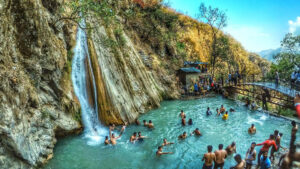“Indulge in the charm of Uttarakhand’s iconic Bal Mithai 🍬 Discover its sweet legacy and unique flavors in every bite! 😍 #BalMithai”
Nestled amidst the picturesque landscapes of Uttarakhand, a northern state in India, is a delightful treat known as “Bal Mithai.” This traditional sweet holds not only a special place in the hearts of the locals but has also piqued the interest of confectionery enthusiasts worldwide. In this article, we delve into the origins, preparation, significance, and the irresistible charm of Bal Mithai.
Where famous Bal Mithai in Uttarakhand
Famous Bal Mithai in Uttarakhand can be found in the city of Almora. Bal Mithai is a popular traditional sweet of Uttarakhand made from khoya (reduced milk) and coated with white sugar balls. Almora is known for its authentic and delicious Bal Mithai, which is widely available in local sweet shops and markets throughout the city. It’s a must-try delicacy if you’re visiting Uttarakhand and want to experience its unique culinary offerings.
The Origin Story
Bal Mithai, which translates to “Child Sweet” in English, traces its origins to the hilly terrains of Uttarakhand. This beloved confectionery has been an intrinsic part of the region’s culinary heritage for generations. The captivating tale behind its name involves a charming twist that adds to its allure.
Ingredients: A Sweet Symphony
Crafting Bal Mithai involves a harmonious blend of simple yet essential ingredients. Milk, sugar, khoya (reduced milk solids), and a touch of cardamom come together to create this delectable treat. The distinctiveness of Bal Mithai lies in its preparation process, which turns these basic ingredients into a culinary masterpiece.
Crafting the Confectionery
The art of making Bal Mithai is an intricate process that requires skill and patience. The milk is first solidified into khoya, which is then mixed with sugar and cardamom to create a rich, flavorful base. The mixture is then shaped into small cubes and coated with crystallized sugar, giving the sweet its unique appearance.
Unique Texture and Flavor
Bal Mithai’s appeal extends beyond its taste; it’s also cherished for its distinctive texture. The contrast of the grainy outer layer with the softness of the inner khoya creates a delightful mouthfeel. The flavor is a harmonious balance of sweetness and the aromatic essence of cardamom.
Festivals and Celebrations
This treat plays an integral role in Uttarakhand’s festivities. It graces numerous celebrations, including weddings, festivals, and special occasions. The exchange of Bal Mithai symbolizes goodwill and happiness, making it an essential part of the region’s social fabric.
Bal Mithai and Culture
Beyond its culinary significance, Bal Mithai reflects the cultural ethos of Uttarakhand. It embodies the warmth of hospitality and the joy of sharing. The sweet’s connection to local traditions makes it an emblem of the state’s rich heritage.
The Perfect Souvenir
For tourists exploring Uttarakhand, Bal Mithai is an ideal souvenir to take back home. Its unique appearance and rich flavor offer a sensory experience that encapsulates the essence of the region.
Preserving a Culinary Heritage
While modern confectioneries have their allure, Bal Mithai stands as a testament to the preservation of age-old culinary practices. It reminds us of the value of retaining traditional methods in a rapidly changing world.
Spreading Sweet Joy: Beyond Uttarakhand
In recent years, Bal Mithai has transcended geographical boundaries. Its popularity has grown, and it’s now savored by people across India and beyond. This expansion of its reach reflects the universal appeal of this remarkable sweet.
Health and Nutrition Perspective
Bal Mithai, a traditional sweet from Uttarakhand, is beloved for its rich taste and cultural significance. However, from a health and nutrition perspective, it’s important to consider its ingredients and consumption in moderation.
Ingredients: Bal Mithai is primarily made from khoya (reduced milk) and sugar, with variations that may include nuts, saffron, and cardamom. While khoya provides some protein and calcium, it’s also high in saturated fats and calories. Sugar contributes to the sweetness but adds empty calories without any significant nutritional value.
Caloric Content: Bal Mithai is energy-dense due to its high sugar and fat content. A small serving can provide a substantial number of calories, which might not align well with a balanced diet, particularly if you’re watching your calorie intake.
Saturated Fats and Sugar: The saturated fats in khoya can have adverse effects on heart health if consumed excessively. The sugar content contributes to the sweet taste but can lead to blood sugar spikes, especially for individuals with diabetes or those who are at risk.
Portion Control: Enjoying Bal Mithai in moderation is key. Instead of indulging in large quantities, opt for a smaller portion to satisfy your sweet cravings without overwhelming your calorie and sugar intake.
Nutritional Alternatives: Considering the high calorie and sugar content of Bal Mithai, exploring healthier sweet options might be beneficial. For example, incorporating fresh fruits, yogurt-based desserts, or homemade treats with controlled sugar can be better choices from a nutritional standpoint.
Cultural and Occasional Indulgence: Bal Mithai holds cultural and sentimental significance, often associated with celebrations and festivals. As such, it’s reasonable to enjoy it occasionally as part of cultural experiences. Just be mindful of portion sizes and balance it with other nutritious choices in your diet.
Bal Mithai: Then and Now
Bal Mithai, a delectable traditional sweet from the hilly state of Uttarakhand in India, has a rich history that spans generations. This sweet treat, which translates to “child’s sweet,” has evolved over time while retaining its distinct flavors and cultural significance.
Origin and Ingredients: Bal Mithai originated in the Kumaon region of Uttarakhand, primarily in places like Almora and Pithoragarh. It was traditionally prepared using simple ingredients like khoya (reduced milk), sugar, and local flavors. The process involved cooking khoya until it turned into a rich caramel color and then coating it with tiny white sugar balls, creating a delightful contrast in both texture and taste.
Evolution of Recipe: Over the years, the basic recipe of Bal Mithai has remained largely unchanged. However, some variations and innovations have emerged. Some artisans now experiment with additional ingredients such as nuts, saffron, and cardamom to enhance the flavor profile. While the core essence of Bal Mithai remains intact, these adaptations offer a contemporary twist to the traditional recipe.
Cultural Significance: Bal Mithai has deep cultural roots in Uttarakhand. It is often associated with celebrations, festivals, and special occasions. Its sweet and slightly nutty taste has the power to evoke nostalgia among locals and captivate the palates of visitors. This dessert holds sentimental value, reminding people of their childhood and the flavors that have been passed down through generations.
Global Recognition: In recent years, Bal Mithai has gained attention beyond Uttarakhand’s borders. With the rise of food tourism and the demand for authentic regional cuisine, this traditional sweet has found its way onto menus and food festivals in other parts of India and even internationally. This recognition has encouraged local artisans to preserve traditional methods while also embracing opportunities for innovation.
Challenges and Sustainability: Despite its enduring popularity, the craft of making Bal Mithai faces challenges. The availability of high-quality ingredients and the labor-intensive process of preparation can make it difficult for traditional sweet makers to maintain the same standards. Efforts to sustain this culinary heritage include workshops, cultural events, and initiatives to support local artisans.
Savory Pairings: A Culinary Adventure
While Bal Mithai is sweet on its own, culinary enthusiasts have discovered its potential in unique pairings. From ice creams to cheeses, its distinctive flavor profile adds a creative touch to various dishes.
Homemade Bal Mithai: A Recipe
Bal Mithai, a delightful sweet from Uttarakhand, can be enjoyed in the comfort of your home with this simple homemade recipe. While preserving the traditional flavors, this recipe offers a step-by-step guide to crafting this treat.
Ingredients:
- 2 cups khoya (milk solids)
- 1 cup powdered sugar
- 1/4 teaspoon cardamom powder
- 1/4 cup chopped nuts (such as almonds, cashews, or pistachios)
- 1 tablespoon ghee (clarified butter)
- Sugar balls or pearls for coating
Instructions:
- Prepare the Khoya:
- You can either buy khoya from a store or make it at home by simmering milk until it thickens and solidifies. Allow the khoya to cool before using it in the recipe.
- Roast the Nuts:
- Heat a pan on low-medium heat and add a tablespoon of ghee.
- Add the chopped nuts to the pan and roast them until they turn slightly golden and aromatic. Remove them from the pan and set aside.
- Mixing the Ingredients:
- In a mixing bowl, crumble the khoya to break any lumps.
- Add the powdered sugar and cardamom powder to the crumbled khoya. Mix well until the sugar is evenly distributed.
- Adding Nuts:
- Gently fold the roasted nuts into the khoya-sugar mixture. This will add a delightful crunch to the Bal Mithai.
- Shaping the Bal Mithai:
- Take a small portion of the mixture and roll it into a small ball, about the size of a walnut.
- Repeat this process to create more Bal Mithai balls.
- Coating with Sugar Balls:
- In a separate bowl, place the sugar balls or pearls that are commonly used for coating Bal Mithai.
- Roll each khoya ball in the sugar balls, pressing gently to make sure they adhere to the surface.
- Setting and Serving:
- Place the coated Bal Mithai on a plate or tray lined with parchment paper.
- Allow them to set at room temperature for a few hours until the sugar coating becomes firm.
- Serve and Enjoy:
- Once the Bal Mithai are set, they are ready to be enjoyed.
- Serve these homemade treats as a delightful dessert or share them with friends and family.
Note:
- Remember that this recipe is a homemade version, and while it captures the essence of traditional Bal Mithai, there might be slight variations in taste and texture.
- Adjust the quantity of sugar and nuts according to your preference.
- Be cautious with portion sizes due to the high calorie and sugar content.
Enjoy your homemade Bal Mithai, and relish the authentic flavors of this cherished Uttarakhand sweet!
Exploring Variations
As Bal Mithai gains popularity, artisans are experimenting with flavors and presentations. From nut-filled versions to saffron-infused renditions, these variations offer exciting alternatives while paying homage to the classic recipe.
Conclusion
Bal Mithai, the beloved “Child Sweet” of Uttarakhand, embodies the state’s culture, heritage, and flavors. Its journey from a regional delicacy to a global delight is a testament to its timeless appeal. As you relish its unique texture and flavor, let Bal Mithai remind you of the joy of savoring tradition in every bite.
FAQs
What is the significance of Bal Mithai in Uttarakhand’s culture?
Bal Mithai holds a significant place in local celebrations and reflects the region’s traditions of sharing happiness.
Can I find Bal Mithai outside of Uttarakhand?
Yes, Bal Mithai’s popularity has led to its availability in various parts of India and even internationally.
Is Bal Mithai suitable for people with dietary restrictions?
Due to its ingredients, Bal Mithai may not be suitable for those with specific dietary restrictions. It’s best enjoyed in moderation.
How can I make Bal Mithai at home?
You can create Bal Mithai at home using khoya, sugar, and cardamom. Follow the simple recipe provided in this article.
What makes Bal Mithai a unique souvenir?
Bal Mithai’s distinct appearance and cultural significance make it a memorable and unique souvenir from Uttarakhand.





